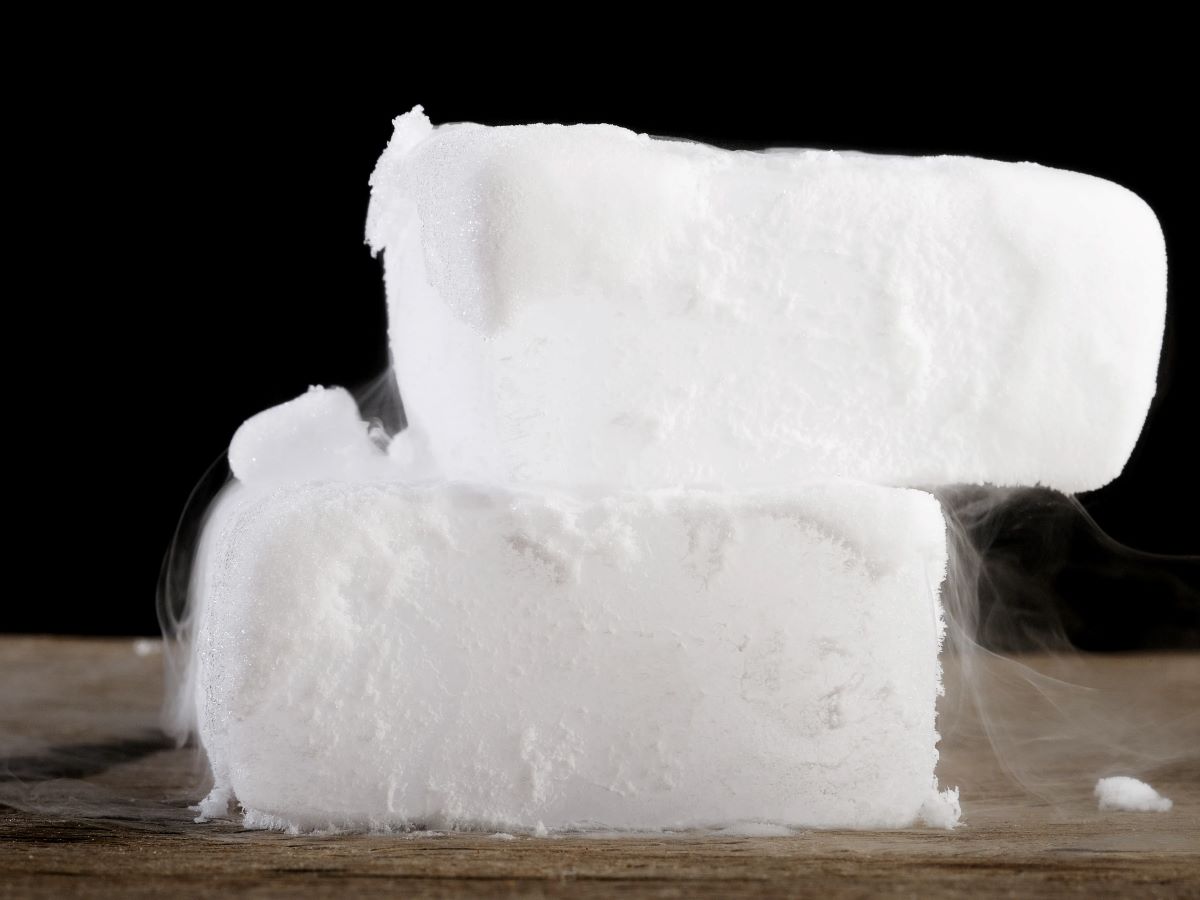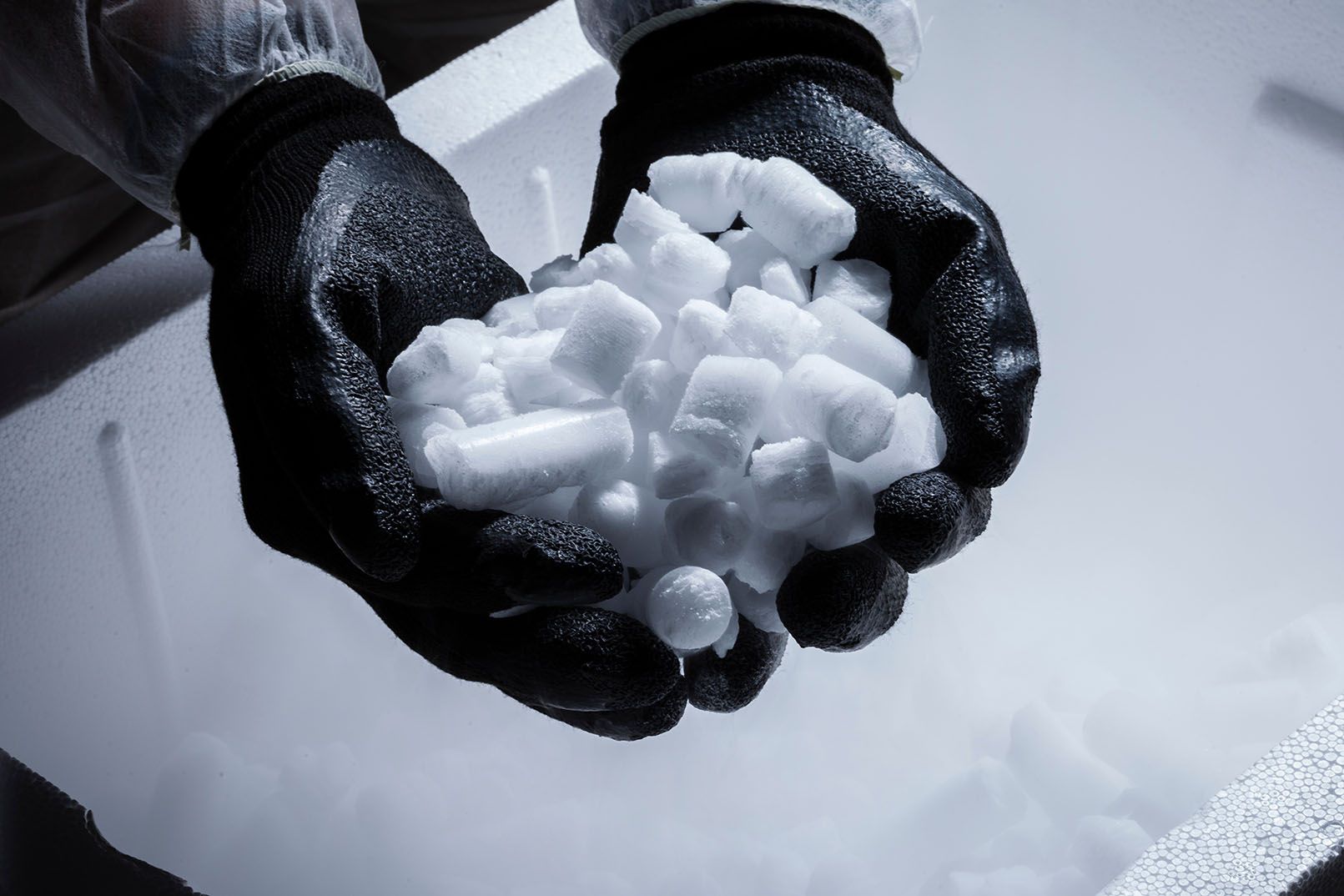

Articles
How To Store Dry Ice Long Term
Modified: February 23, 2024
Discover the best methods for storing dry ice long term in this informative article. Learn how to keep your dry ice fresh and usable for extended periods.
(Many of the links in this article redirect to a specific reviewed product. Your purchase of these products through affiliate links helps to generate commission for Storables.com, at no extra cost. Learn more)
Introduction
Dry ice, also known as solid carbon dioxide, is an incredibly versatile substance that is often used for a variety of purposes, such as preserving perishable items, creating special effects, and even in some scientific experiments. However, when it comes to storing dry ice long term, it requires careful consideration and proper handling.
In this article, we will explore the best practices for storing dry ice to ensure its longevity and effectiveness. We will cover important safety precautions, selecting the right storage container, wrapping and insulating the dry ice, and monitoring and replenishing it. By following these guidelines, you can extend the shelf life of your dry ice and make the most out of its many benefits.
Before diving into the specifics of storing dry ice, let’s first gain a better understanding of this unique substance.
Key Takeaways:
- Properly storing dry ice requires selecting the right container, insulating it effectively, and monitoring its condition to ensure longevity and optimal cooling properties.
- Safety precautions, such as wearing protective gear and ensuring proper ventilation, are essential when handling and storing dry ice to avoid accidents and health risks.
Read more: How To Store Dry Milk Long Term
Understanding Dry Ice
Dry ice is the solid form of carbon dioxide, a gas that we commonly exhale when we breathe. When carbon dioxide is cooled to a temperature below -78.5 degrees Celsius (-109.3 degrees Fahrenheit), it transforms into a solid state without undergoing a liquid phase. This process is called sublimation.
One of the unique properties of dry ice is that it sublimates directly from a solid to a gas without leaving behind any liquid residue. This means that it doesn’t melt like regular ice. Instead, it transforms into carbon dioxide gas, creating a cloudy smoke-like effect.
Dry ice is commonly used for its cold temperature, which hovers around -78.5 degrees Celsius. This makes it ideal for preserving perishable items and maintaining low temperatures in various settings. Its extreme coldness makes it useful in transportation, medical research, food storage, and more.
However, it is important to handle dry ice with caution, as direct contact can cause frostbite or burns due to its extremely low temperature. It is essential to follow proper safety procedures and use suitable storage containers to avoid any accidents or health risks.
Now that we have a basic understanding of dry ice, let’s move on to discussing the safety precautions that are necessary when handling and storing it.
Safety Precautions
When it comes to handling and storing dry ice, following proper safety precautions is of utmost importance to ensure the well-being of yourself and others. Here are some essential safety measures to keep in mind:
- Protective Gear: Always wear insulated gloves or use tongs when handling dry ice. This will shield your hands from the intense cold and prevent any accidental contact or burns.
- Ventilation: Make sure the area where you store dry ice is well-ventilated. Carbon dioxide gas can displace oxygen in an enclosed space, leading to asphyxiation. Keep doors or windows open to allow proper airflow and prevent build-up of gas.
- Storage Location: Choose a storage location that is cool, dry, and away from direct sunlight. Avoid storing dry ice in non-ventilated areas, such as a sealed container, as it can cause the container to expand or rupture due to the buildup of gas pressure.
- Children and Pets: Keep dry ice out of the reach of children and pets. Explain the dangers of direct contact and ensure they are not in the vicinity when handling or storing dry ice.
- Proper Disposal: When disposing of dry ice, do not dispose of it in regular trash bins or down the drain. Allow it to sublimate in a well-ventilated area or consult your local waste disposal facility for specific guidelines.
By adhering to these safety precautions, you can minimize the risk of accidents and ensure a safe storage environment for dry ice. Now, let’s move on to selecting the right storage container for long-term storage.
Selecting the Right Storage Container
Choosing the appropriate storage container is crucial for effectively storing dry ice long term. Here are some factors to consider when selecting the right container:
- Insulation: The storage container should have good insulation to minimize the sublimation rate of the dry ice. Insulated containers help maintain low temperatures, extending the shelf life of the dry ice.
- Tight Seal: Ensure that the storage container has a tight seal to prevent the entry of warm air. Any air leakage can accelerate the sublimation process, causing the dry ice to dissipate more quickly.
- Size and Capacity: Choose a container that is appropriately sized for the amount of dry ice you intend to store. It should have enough capacity to accommodate the dry ice without crowding or excessive empty space.
- Durable Material: Opt for a storage container made from durable materials that can withstand the extreme cold temperatures of dry ice. Stainless steel, heavy-duty plastic, and insulated coolers are commonly used and recommended options.
When considering the storage container, it is also important to take into account the duration of storage. If you require long-term storage, investing in a well-insulated cooler or a dry ice storage container specifically designed for extended preservation can be beneficial.
Now that we have selected the right storage container, the next step is to properly wrap and insulate the dry ice within the container. This will help maintain its temperature and slow down the sublimation process. Let’s explore how to do so in the next section.
Wrapping the Dry Ice
Properly wrapping the dry ice is essential to maintain its temperature and slow down the sublimation process. Here are some steps to follow when wrapping the dry ice:
- Use Insulating Material: Begin by placing a layer of insulating material on the inside of the storage container. This material can be newspaper, cardboard, or a towel. The insulating layer helps to minimize heat transfer and keeps the dry ice colder for longer.
- Wrap the Dry Ice: Next, carefully wrap the dry ice in a few layers of newspaper or place it in a plastic bag. Ensure that you securely fasten the wrapping to prevent air leakage.
- Add Additional Insulation: Once the dry ice is wrapped, place it inside the storage container. Fill any empty spaces with more insulating material, such as towels or packing peanuts. This extra insulation helps maintain a consistent temperature and reduces sublimation.
It’s important to note that you should never store dry ice in an airtight container. As dry ice sublimates, it releases carbon dioxide gas, and storing it in an airtight container can cause a dangerous build-up of pressure.
Now that the dry ice is wrapped and ready for storage, let’s move on to insulating the storage container to further extend its shelf life.
Read more: How To Store Dry Food Long Term
Insulating the Container
Proper insulation plays a crucial role in extending the shelf life of dry ice by preventing heat transfer and maintaining a consistently low temperature. Here are some methods to effectively insulate the storage container:
- Double-Layered Container: Consider using a double-layered container to provide an extra layer of insulation. This can be achieved by placing the container with the wrapped dry ice inside a larger, insulated container or cooler.
- Foam Inserts: If a double-layered container is not available, you can use foam inserts or insulating materials to create a barrier between the inner container and the outer environment. These inserts help minimize heat transfer and maintain the cold temperature inside the container.
- Tight Lid: Ensure that the storage container has a tight-fitting lid or cover to prevent warm air from entering and cold air from escaping. A secure seal keeps the internal temperature stable and slows down the sublimation process.
- Avoid Opening Frequently: Limit the frequency of opening the storage container. Every time the container is opened, warm air enters, causing the dry ice to sublimate faster. Plan ahead and retrieve the necessary items in one go to minimize exposure to external heat.
Remember that maintaining a consistently low temperature is crucial for long-term storage of dry ice and to minimize the loss of its cooling efficacy. By insulating the storage container properly, you can significantly prolong the shelf life of the dry ice.
Now that we have covered the methods for insulating the container, let’s explore different storage options for dry ice, such as using a freezer, cooler, or Styrofoam box.
Store dry ice in a well-insulated cooler with a tight-fitting lid to minimize sublimation. Place the cooler in a well-ventilated area, and avoid keeping it in a tightly sealed space to prevent pressure buildup.
Storing Dry Ice in a Freezer
Using a freezer to store dry ice is one of the most common methods, as it provides a controlled and consistently low temperature. Here are the steps to follow when storing dry ice in a freezer:
- Prepare the Freezer: Make sure the freezer is clean and has enough space to accommodate the dry ice. Remove any perishable items or items that may come into contact with the dry ice.
- Wrap the Dry Ice: Follow the previously mentioned steps to wrap the dry ice in newspaper or place it in a plastic bag, ensuring a secure wrapping.
- Place the Dry Ice in the Freezer: Put the wrapped dry ice inside the freezer. Make sure it is placed away from any fan or vent to avoid the cold air being blown directly onto it.
- Insulate the Dry Ice: If the freezer has empty space, you can add an additional insulating layer by placing towels or insulating material around the dry ice. This helps maintain a consistently cold temperature.
- Avoid Overcrowding: Ensure that the dry ice is not overcrowded among other items in the freezer. Providing enough space allows the cold air to circulate effectively and prevents the dry ice from coming into contact with warm items.
It’s important to note that using a freezer to store dry ice may affect the freezer’s regular operation. Some freezers may have a safety feature that automatically shuts off when the temperature drops too low. Consult the freezer’s manual or manufacturer to ensure its compatibility with dry ice storage.
Storing dry ice in a freezer is ideal for long-term storage, as the low temperature helps slow down the sublimation process. However, if you don’t have access to a freezer, you can also consider using a cooler as an alternative storage option, as we will discuss next.
Storing Dry Ice in a Cooler
If you don’t have access to a freezer, storing dry ice in a cooler can be an effective alternative. Coolers provide insulation and help maintain a consistently low temperature. Follow these steps to store dry ice in a cooler:
- Prepare the Cooler: Ensure that the cooler is clean and dry. Remove any items or perishable food from the cooler to make space for the dry ice.
- Wrap the Dry Ice: Wrap the dry ice in newspaper or place it inside a plastic bag. Make sure the wrapping is secure to prevent air leakage.
- Place the Dry Ice in the Cooler: Put the wrapped dry ice inside the cooler. Leave some space around the dry ice to allow for proper airflow.
- Insulate the Cooler: Add an extra layer of insulation by placing towels or insulating material around the dry ice. This helps maintain a low temperature and minimizes the sublimation rate.
- Secure the Cooler: Close the cooler lid tightly to prevent warm air from entering and cold air from escaping. Ensure that there are no gaps or openings that could compromise the insulation.
It’s essential to note that coolers provide insulation, but they aren’t as effective as freezers in maintaining extremely low temperatures. Therefore, it’s best to use coolers for short-term storage of dry ice, such as during transportation or outdoor activities.
If you need to store dry ice for an extended period, consider using a dedicated dry ice storage container or a well-insulated cooler with additional insulation materials.
Now that you know how to store dry ice in a cooler, let’s explore another storage option using a Styrofoam box.
Storing Dry Ice in a Styrofoam Box
A Styrofoam box is an excellent option for storing dry ice, as it provides insulation and helps maintain a consistently low temperature. Follow these steps to store dry ice in a Styrofoam box:
- Choose the Right Size: Select a Styrofoam box that is appropriately sized for the amount of dry ice you plan to store. The box should have enough capacity to accommodate the dry ice without overcrowding.
- Prepare the Styrofoam Box: Ensure that the box is clean and free of any cracks or damage. Clean the box with a mild detergent, rinse it thoroughly, and let it dry completely before use.
- Wrap the Dry Ice: Wrap the dry ice in newspaper or place it in a plastic bag, ensuring a secure wrapping to prevent air leakage.
- Place the Dry Ice in the Styrofoam Box: Put the wrapped dry ice inside the Styrofoam box, ensuring there is enough space around it for proper airflow.
- Insulate the Styrofoam Box: Fill any empty spaces in the box with insulating material, such as towels or packing peanuts. This helps to maintain a consistently low temperature and minimize heat transfer.
- Secure the Box: Close the lid of the Styrofoam box tightly to create a seal. Ensure that there are no gaps or openings that could compromise the insulation.
A Styrofoam box provides excellent insulation and can effectively maintain the cold temperature of the dry ice. It is particularly useful for short-term storage, such as transporting dry ice for special events, camping trips, or outdoor activities.
Remember to handle the Styrofoam box with care, as it can be fragile and prone to damage. Avoid dropping or applying excessive pressure to the box, as it can affect its insulating properties.
Now that you know how to store dry ice in a Styrofoam box, it’s important to monitor and replenish the dry ice to ensure its effectiveness, as we’ll discuss next.
Read more: How To Store Dried Herbs Long Term
Monitoring and Replenishing Dry Ice
Monitoring and replenishing dry ice is crucial to ensure its effectiveness and longevity. Here are some essential steps to follow:
- Regularly Check the Dry Ice: Monitor the dry ice regularly to assess its condition. Check for signs of sublimation, such as significant shrinkage or a decrease in temperature.
- Replenish as Needed: If you notice that the dry ice is significantly diminishing or no longer providing the desired cooling effect, it’s time to replenish it. Purchase fresh dry ice and follow the storage and handling guidelines to ensure its efficacy.
- Dispose of Spent Dry Ice: Dispose of any spent or completely sublimated dry ice properly. Allow it to fully dissipate in a well-ventilated area or consult your local waste disposal facility for guidance on how to dispose of dry ice.
- Be Mindful of Storage Duration: Dry ice has a limited shelf life, even when stored correctly. It’s essential to be mindful of the storage duration and use the dry ice within a reasonable time frame to maximize its cooling properties.
When replenishing dry ice, always handle it with care and follow the necessary safety precautions. Remember to use insulated gloves or tongs to avoid direct contact with the extremely cold dry ice.
By monitoring the condition of the dry ice and replenishing it as needed, you can ensure that it remains effective and provides optimal cooling for your specific needs.
Now that we’ve covered the important steps for storing and monitoring dry ice, let’s conclude our article.
Conclusion
Properly storing dry ice for long-term use requires careful consideration and adherence to essential guidelines. By following the steps outlined in this article, you can ensure the longevity and effectiveness of your dry ice, whether you’re using it for preserving perishable items, creating special effects, or conducting scientific experiments.
Understanding the properties of dry ice and implementing safety precautions is paramount to avoid accidents and health risks. Always wear protective gloves, ensure proper ventilation in the storage area, and handle dry ice with caution.
Selecting the right storage container is key to maintaining the cold temperature of the dry ice. Choose an insulated container with a tight seal to minimize heat transfer and prevent air leakage. If needed, double-layer the container or use foam inserts for additional insulation.
Wrapping the dry ice in insulating material and properly insulating the storage container further helps slow down the sublimation process. Avoid storing dry ice in airtight containers and make sure to leave space for proper airflow.
We have explored various storage options for dry ice, including freezers, coolers, and Styrofoam boxes. Freezers offer a controlled and consistently low temperature, while coolers and Styrofoam boxes provide insulation for short-term storage or transportation.
Monitoring the condition of the dry ice and replenishing it as needed is crucial for optimal performance. Regularly check for signs of sublimation and replenish the dry ice when necessary to maintain its cooling properties.
Remember, dry ice has a limited shelf life, so it’s important to use it within a reasonable time frame and dispose of any spent dry ice appropriately to ensure safety.
By following these guidelines and practicing good storage practices, you can make the most out of your dry ice and ensure its effectiveness whenever you need it.
Frequently Asked Questions about How To Store Dry Ice Long Term
Was this page helpful?
At Storables.com, we guarantee accurate and reliable information. Our content, validated by Expert Board Contributors, is crafted following stringent Editorial Policies. We're committed to providing you with well-researched, expert-backed insights for all your informational needs.














0 thoughts on “How To Store Dry Ice Long Term”